Noticing a dip or wave in your pitched roof isn’t just an aesthetic concern—it can be an early warning sign of underlying structural issues. At LS Roofing Feltham, we frequently deal with uneven roof sag across properties in Feltham, Greater London, and homeowners are often surprised by the range of causes behind this common problem. Understanding what’s causing your pitched roof to sag can help you take timely action before it escalates into a more costly repair.
Common Causes of Roof Sagging
1. Ageing Timber or Roof Structure
Over time, wooden rafters and joists can lose strength due to age, moisture, or long-term stress. This is particularly common in older homes, where original materials may no longer be structurally sound. As these elements begin to fail, parts of the roof may dip or bow unevenly.
2. Excessive Roof Load
Roofs are designed to bear a specific weight. If additional loads—such as heavy tiles, water pooling, solar panels, or even accumulated snow—exceed the original design, it can cause sections of the roof to sag. This is especially problematic if heavier roofing materials have replaced lighter ones without structural reinforcement.
3. Water Damage and Leaks
One of the most destructive causes of sagging is hidden water damage. A leaking roof allows moisture to seep into wooden supports, weakening them over time. Rotting timbers lose their load-bearing capacity, leading to visible sag and even collapse in severe cases.
4. Poor Workmanship or Inadequate Design
In some cases, sagging is the result of improper construction. Undersized rafters, poor-quality materials, or lack of structural bracing can all contribute to an uneven roofline. If your pitched roof wasn’t correctly installed or has had DIY repairs in the past, it may lack the strength needed to maintain its form.
5. Foundation Movement or Subsidence
Issues with the foundations or supporting walls can also lead to roof sagging. If the walls supporting your pitched roof are shifting due to subsidence, the roof may distort in response. This is a more complex structural issue that requires prompt attention to prevent further damage.
Why It’s Important to Address Roof Sag Quickly
Ignoring a sagging roof can lead to serious complications:
- Leaks and water ingress
- Internal ceiling damage
- Risk of collapse in severe cases
- Reduced property value and kerb appeal
- Higher long-term repair costs
In addition to being a safety concern, roof sag may also impact your ability to insure or sell your home, especially if it’s classed as a structural defect.
What to Do If You Notice Sagging
If you spot a dip in your pitched roof, it’s essential to get a professional inspection. At LS Roofing Feltham, we conduct thorough roof surveys across Feltham, Greater London, to identify whether the issue is due to timber failure, water ingress, structural design, or other factors.
We provide straightforward advice, and if repairs are necessary, we offer tailored solutions that restore strength, shape, and safety—whether that involves rafter replacement, roof realignment, or full re-roofing in more severe cases.
Conclusion
Uneven sag in a pitched roof is not something to ignore. Whether it’s down to ageing timber, water damage, or poor construction, addressing the issue early can save you significant stress and money. LS Roofing Feltham offers expert assessments and long-term solutions for homeowners in Feltham, Greater London. If you’ve noticed a dip or bow in your roofline, contact our team today to schedule a professional inspection and keep your home structurally sound.
Call us on: 020 4572 0290
Click here to find out more about LS Roofing Feltham
Click here to complete our contact form and see how we can help with your roofing needs.

